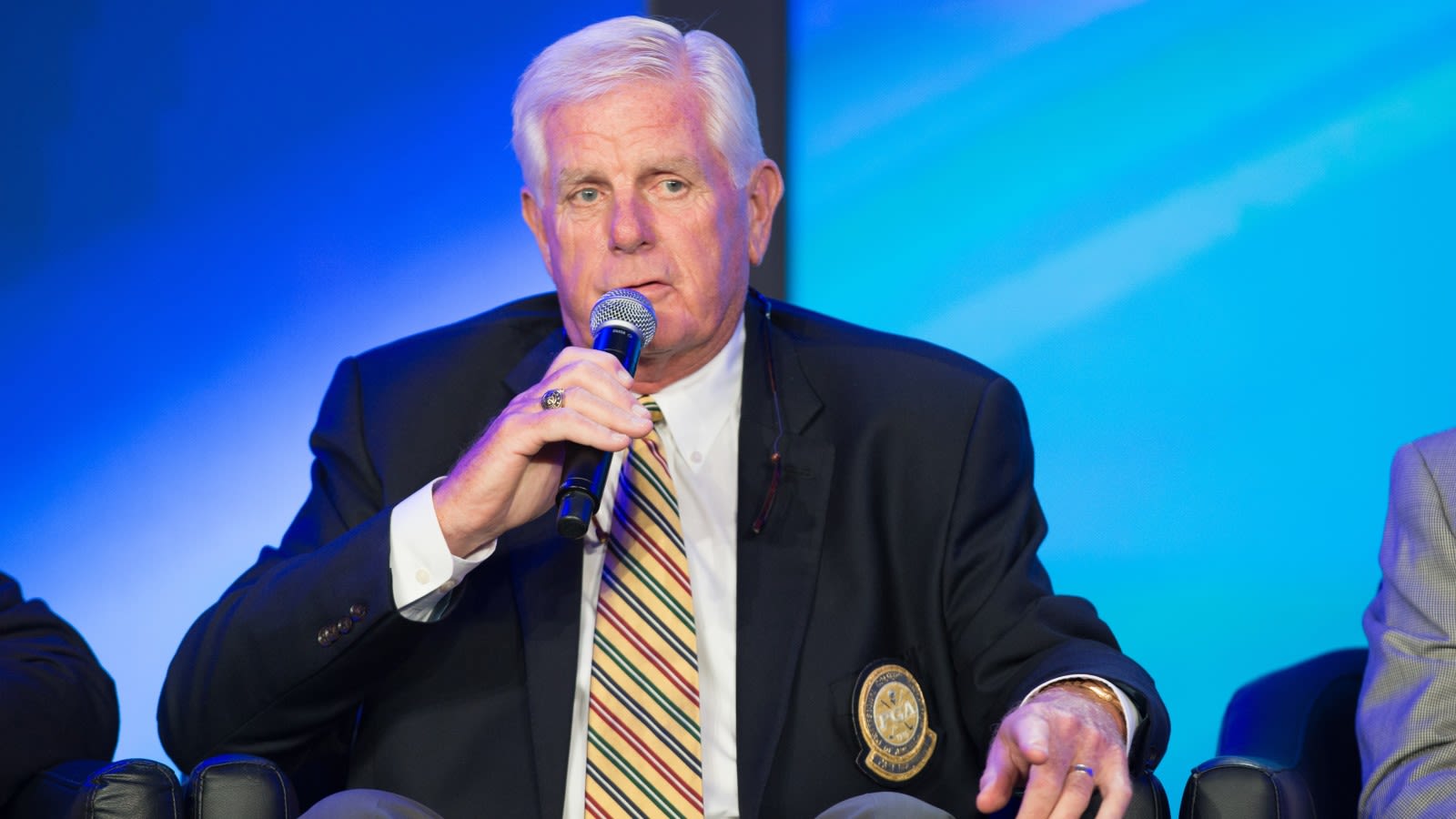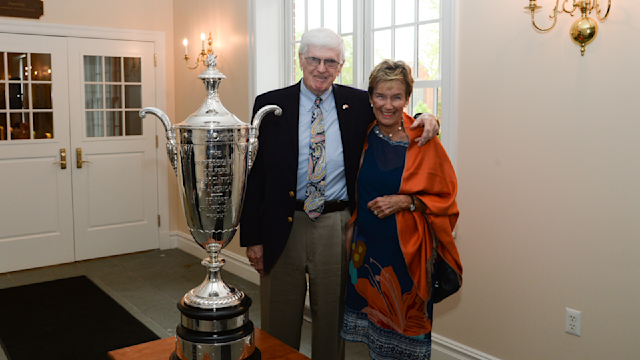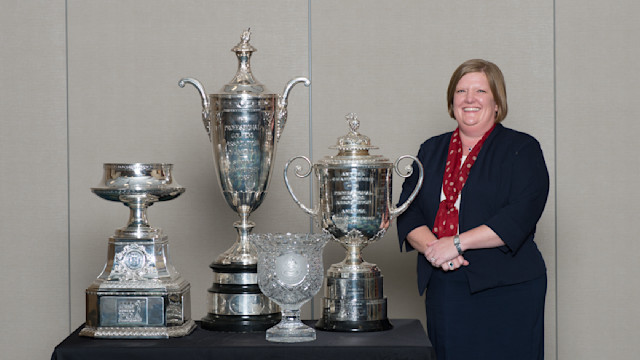Game Changers
A Tribute to PGA Past President Dick Smith Sr.
By Bob Denney, PGA Historian Emeritus
Published on

Dick Smith Sr., the 27th President of the PGA of America and one of the greatest players ever to hold the Association’s highest office, didn’t leave his competitiveness on the golf course.
Smith transferred that tenacity into the boardroom and to his passion for programs that benefited aspiring PGA Professionals. As president, Smith created the modern approach to professional development and PGA Member education. During his time as an officer, PGA Membership nearly doubled.
One of the most influential members of the Philadelphia PGA Section, Smith passed away March 8 in Voorhees, New Jersey, following complications from a stroke. He was 80.
“He was a grassroots golf professional,” said his son, Dick Smith Jr., the PGA Director of Golf at Kingwood (Texas) Country Club. “He truly cared about the PGA Member and the PGA of America. It wasn’t about him. It was about making the PGA and the PGA Member better for everyone that followed him.”
Smith competed in 13 major championships during his career, highlighted by a tie for 44th place at the 1970 U.S. Open and a 17th place showing at the 1992 Senior British Open.
“Dick had a great influence on our sport, both as a leader and a competitor,” said PGA President John Lindert, the PGA Director of Golf at the Country Club of Lansing in Michigan. “One of the finest playing presidents in our Association’s history, his service as PGA President from 1991-92 was extremely impactful on our membership, the game and the golf industry.
"Our thoughts and prayers go out to the Smith family, including his wife Adrienne, daughter Stephanie, and son and Quarter Century PGA Member Dick Jr., along with his grandchildren Alexandria, Zakary and Marissa.”
From caddie to PGA President
Smith presided over a dynamic period in the PGA’s history, while realizing the need for ongoing planning to ensure the continued success of the Association.
“We need to have the ability to look forward and anticipate what our game and our business will be in five, 10, 20 years,” said Smith. “Once we identify that, we have to be ready to accept what’s necessary to achieve it.”
Born Richard Lie-Nielsen Smith, on June 16, 1942, in Akron, Ohio, he was 10 years old when he first started going to the golf course with his father, Robert. The youngster first picked up the game as a caddie, and soon learned to excel.
Smith captured the 1959 Maryland State Jaycee Championship at age 17. Three years later, he began working as an assistant professional at Green Valley Country Club in Lafayette Hill, Pennsylvania.
Smith subsequently would hone his skills at Laurel Oak Country Club in Gibbsboro, New Jersey; Indian Spring Golf Club in Marlton, New Jersey; High Point Golf Club in Ivyland, Pennsylvania; Wedgwood Country Club in Turnersville New Jersey; Woodcrest Country Club in Cherry Hill, New Jersey; Galloway (New Jersey) National Golf Club; the Williamstown (New Jersey) Golf Center; Bethpage (New York) State Park; Riverwinds Golf Club in West Deptford, New Jersey; and White Oaks in Newfield, New Jersey. Smith also founded The Golf Group, a golf course consulting firm in 2004.
From 2008 until his death, Smith served Valleybrook Country Club in Blackwood, New Jersey.
Smith attended Loyola College in Baltimore, turned professional in 1961, and was elected to PGA Membership in 1964. A dominant figure in the Philadelphia PGA Section, he competed in five PGA Championships, the 1970 U.S. Open, 1992 Senior British Open and 11 PGA Professional Championships. He was a five-time Philadelphia PGA Champion (matched only by Art Wall). Smith won over 25 championships during his playing career.
Smith caddied for his son in 2007, when Dick Jr. made his debut in the PGA Professional Championship in Sunriver, Oregon. When Smith earned a berth in two U.S. Senior Opens, both at Saucon Valley in Bethlehem, Pennsylvania, his brother Tom caddied for him in 1992, while Dick Jr. had the bag in 2000.
“My dad was a great player in the Section, at the national level, and he sacrificed a very successful PGA Tour Champions career by devoting his time to the PGA of America,” said Smith Jr.
Smith Sr. demonstrated that his abilities were not limited to playing. He was elected Vice President of the Philadelphia PGA in 1975, and was President from 1978-80. In 1984, Smith was elected to the national PGA Board of Directors, followed by a run for national PGA Secretary . . . which he won.
“I felt I represented a point of view that was important,” said Smith. “I represented the view of the rank and file.”
Celebrating 75 years with an eye toward the future
That passion for the PGA Member was inspirational for one of his closest friends, former PGA President Jack Connelly of Huntingdon Valley, Pennsylvania, who met Smith when competing in Section events. In fact, Smith, Dick Hendrickson and Connelly were the “Big Three” of Philadelphia PGA Section golf.
Smith won six Section Player of the Year awards, Hendrickson five, and Connelly four.
“He’s one of those guys you trust and a forward thinker,” said Connelly. “He thinks before he talks. It’s like E.F. Hutton (the famed commercial): 'When Dick Smith talks, everybody listens.' ”
Standing 6-foot-5, Smith towered over most of his colleagues, and was elected PGA President in November 1990 as the PGA prepared to celebrate its 75th anniversary in 1991. His primary focus was on education, employment and public awareness.
Using the 75th anniversary as a launching pad, three major events catapulted the PGA to the forefront. First, Jack Nicklaus captured the 1991 Senior PGA Championship on PGA National Golf Club’s Champion Course, which he had just redesigned near his home in South Florida. Smith presented the Alfred Bourne Trophy to Nicklaus for his wire-to-wire, six-stroke victory on national television.
A few months later in August, John Daly, a little-known 26-year-old from Arkansas, drove all night to enter the 1991 PGA Championship as the ninth alternate at Crooked Stick Golf Club, then stormed to victory in one of the greatest Walter Mitty tales in sports history.
“I just remember John walking up the 18th fairway as we were standing back by the hole, and he’s pumping up the crowd because he was a crowd pleaser,” said Smith years later. “He loved the crowd.” With extended television coverage on all four days of the event, the PGA Championship took on an exciting new identity with Daly’s victory.
The following month, the United States won the Ryder Cup on The Ocean Course at Kiawah Island in South Carolina. The classic seesaw battle came down to the last putt on the last hole in the last match. Smith was alongside the 18th green with Captain Dave Stockton and the U.S. Team.
“The players were sitting in front of me, so I couldn’t see the final putt,” said Smith. “All I heard was the crowd. As the crowd roared, I stood up and saw the ball still sitting there, so I knew what had happened.” European stalwart Bernhard Langer missed a six-foot putt that would have won the Ryder Cup for Europe. As a result, the Langer vs. Hale Irwin match was halved, and the United States won for the first time since 1983.
By the end of the year, a revised PGA Grand Slam of Golf — featuring a $1 million purse for the winners of golf’s four major championships — was broadcast in primetime television from Hawaii and provided another promotional opportunity.
Those electrifying golf events of 1991, coupled with a new national promotional campaign, provided the PGA with the positive exposure it needed to communicate its message to the masses. Revised television contracts that included expanded broadcast distribution to more than 100 countries ensured a global reach for PGA messages.
Modernizing PGA Education
PGA “Business Schools” had been in place for almost 30 years when the PGA moved to modernize apprentice education.
“The PGA Education Program needs to be upgraded to reflect the needs of today’s industry,” wrote Smith, an advocate of PGA Professional certification.
Smith and the PGA Board engaged SRI International, a Stanford, California, educational firm, to review and assess how the PGA was educating prospective PGA Members. The result of this appraisal was the creation of the PGA Golf Professional Training Program (GPTP). This new program would introduce the golf industry to a new breed of PGA Professionals well-trained in all aspects of the game.
Smith believed that education was the key to employment. It was especially challenging as the PGA was experiencing an unprecedented growth phase to keep up with industry demand.
“When I became an officer, we had 12,000 to 13,000 Members and Apprentices,” recalled Smith. “When I went out as PGA President, we had 24,000.”
The PGA then embarked on creating a new program, PGA Career Services, which would enable PGA Professionals to help find meaningful employment, while providing to employers qualified candidates.
In 1991, the PGA reached another milestone with its 20,000th Member, which would test the consensus-building skills of PGA leaders.
“We need to listen to each other,” said Smith. “We need to have compassion for someone else’s point of view because that point of view is based on input from other members of our Association. The people in the east can’t forget that the Association also includes people in the west. And the people in the north have to understand the needs, problems and desires of the people in the south.”
Before the year was out, Smith would invite the first African-American and first woman to join the PGA Advisory Committee, which helped provide guidance to the rapidly growing organization.
When Smith was the PGA Director of Golf at Bethpage's famed Black Course, he became “graphic designer” when it was becoming crunch time and a logo was needed for the 2002 U.S. Open.
“My father told me he pulled up to his parking spot and looked at the shutters on the clubhouse,” said Smith Jr. “He said, ‘I’ve just figured it out.’ He pulled that caddie boy image off and got it in front of the art people. He said that they should add the five colors of the courses at Bethpage. It was approved and it became the U.S. Open logo.”
Smith Sr., who was a 1992 inductee of the Philadelphia PGA Hall of Fame and a 2005 PGA Hall of Famer, shares a rare Association honor of service with his son in the Philadelphia PGA Section. Dick Sr. was Section President from 1978-80, and Dick Jr. from 2006-07.
“I will always remember him spending five days with me at the PGA Professional Championship in Sunriver, Oregon,” said Smith Jr. “I missed the cut, but that was fine. I spent five days there with him on my bag, and I wouldn’t have traded that for anything in the world.”


